2024 Qualifying Quiz
- The picture below shows a variant of a famous paradoxical puzzle. On the left, we take two rectangles of area 60, and cut each one into two pieces. On the right, we rearrange the four pieces, and put them together into a single rectangle of area 119. How could this be?

- Explain what's wrong. (Similar paradoxes can be found under names such as "Chessboard paradox" or "Missing square puzzle". It's fine to look at a source that explains such a paradox, provided you cite it — and explain it in your own words.)
- Although two 5 × 12 rectangles cannot really be rearranged into a 7 × 17 rectangle, it is possible to take two a × b rectangles and cut them as shown in the picture above to make a c × d rectangle, with no paradox. What should the lengths a, b, c, d be (up to scaling, of course)?
- It is also possible to take three congruent rectangles, cut each one into two pieces, and rearrange them to form a single rectangle similar to the original three. How can we do this?
Try to find an answer that lets you create a paradoxical decomposition of your own!
-
Kayla has two red boxes, two green boxes, and two blue boxes. Each of the six boxes contains a secret number. Kayla hands the boxes to Leo and asks him to write the letters A, a, B, b, C, and c, on the boxes. We will write #A, #a, #B, #b, #C, and #c to refer to the secret numbers inside these boxes.
From there, the boxes go to Maya, who opens the boxes and reports the differences #A−#a, #B−#b, and #C−#c, (in that order). Next, the boxes go to Nathan, who opens the boxes and reports the sum of the numbers in the red boxes, the sum of the numbers in the green boxes, and the sum of the numbers in the blue boxes (in that order). The resealed boxes, along with Maya's and Nathan's reports, are then handed back to Kayla, who must determine the numbers in each of the boxes.
Kayla expected Leo to label same-color boxes with the same letter, which would have made it easy for Kayla to figure the numbers: for example, knowing #A−#a from Maya and #A+#a from Nathan, Kayla could solve for #A and #a. However, to Kayla's surprise, Leo is color blind, so his labeling had nothing to do with the colors.
- For which of the labelings that Leo used is it still possible for Kayla to determine the six secret numbers? (Kayla can see which colors have which labels on them.)
- Generalize your answer to a problem with 2n boxes of n different colors, labeled with n different uppercase and lowercase letters.
-
Here is a curious fact you may not have known about mathematicians: when asked a yes-or-no question, number theorists will always tell the truth, while analysts will always lie. Be careful: if you ask someone a yes-or-no question, and they cannot answer either "yes" or "no" to it, then the universe explodes in paradox. For example, this happens if you ask an number theorist, "Is your answer to this question 'no'?"
- What yes-or-no question can be asked to both a number theorist and an analyst to cause the universe to explode in both cases?
- To try to prevent the universe from exploding in paradox, logicians have decided to act as paradox detectors. When you ask a logician a yes-or-no question, the logician will answer "yes" if asking the question to a number theorist would cause the universe to explode, and "no" otherwise. For example, if you ask a logician, "Is your answer to this question 'no'?" the logician will answer "yes".
What yes-or-no question can be asked to a logician to cause the universe to explode?
-
A group of 11 Mathcampers decided to bake a rainbow unicorn sprinkle cake with 10 slices. Unfortunately they cannot split up the slices into smaller pieces, because they do not want to risk upsetting the unicorn. Each Mathcamper wants a slice of the cake (but not more, because Mathcampers aren't greedy). Each Mathcamper helped bake the cake to some extent. The Mathcampers have been assigned fractions x1, x2,. . ., x11 representing their share of the credit in baking the cake, where 0 < xi < 1/10 for each i, and x1 + x2 + . . . + x11 = 1.
- How can you randomly distribute the slices of cake such that the ith Mathcamper has a probability of exactly 10xi of getting a slice of cake?
-
Generalize your solution to distribute k slices to n campers, for all k and n with n > k ≥ 1.
As before, the Mathcampers have been assigned fractions x1, x2,. . ., xn representing their share of the credit in baking the cake, where 0 < xi < 1/k for each i, and x1 + . . . + xn = 1; for each i, you want the ith Mathcamper to have a probability of exactly kxi of getting a slice of cake.
- Suppose that, in the setup of part b, you do not know the value of k (the number of slices). Instead, you will put the Mathcampers in a random order, according to some strategy, and then serve slices of cake in that order until the cake runs out. Is there a way to do this so that for each i, the ith Mathcamper will have a probability of exactly kxi of getting a slice of cake — no matter what k turns out to be? (You may still assume that we have 0 < xi < 1/k for all i, and x1 + . . . + xn = 1.
-
"Half stitching" is a form of embroidery which makes images out of diagonal stitches in a square grid. Our images will all be created from a single thread, which alternates traveling in straight lines (called stitches) along the front and the back of the grid:
- The front of the grid is where the image is formed. Here, each stitch goes from a point (x,y) either to (x+1,y+1) or (x−1,y−1). We say that we stitch a square if a stitch on the front follows its diagonal (from top right to bottom left or from bottom left to top right).
- The back of the grid is not part of the image. Here, each stitch can follow any straight line — but it must travel a positive distance, because if you end a stitch where it started, it will unravel.
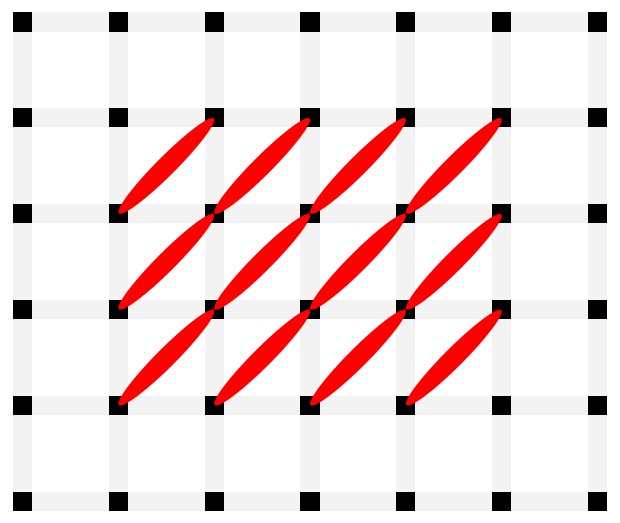
(a) A 3×4 grid 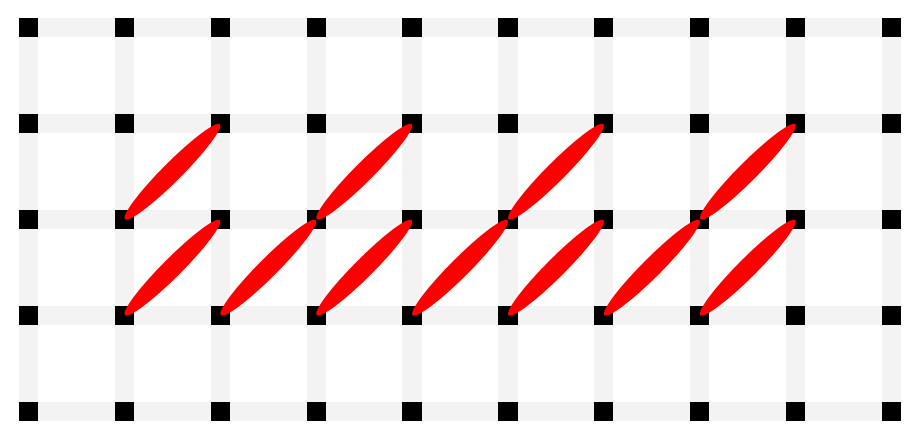
(b) A comb with 4 teeth 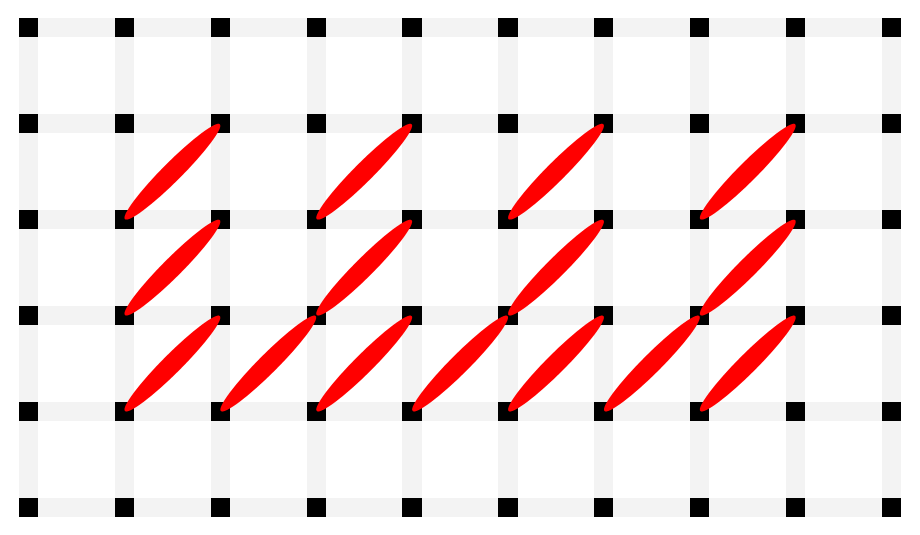
(c) A tall comb with 4 teeth 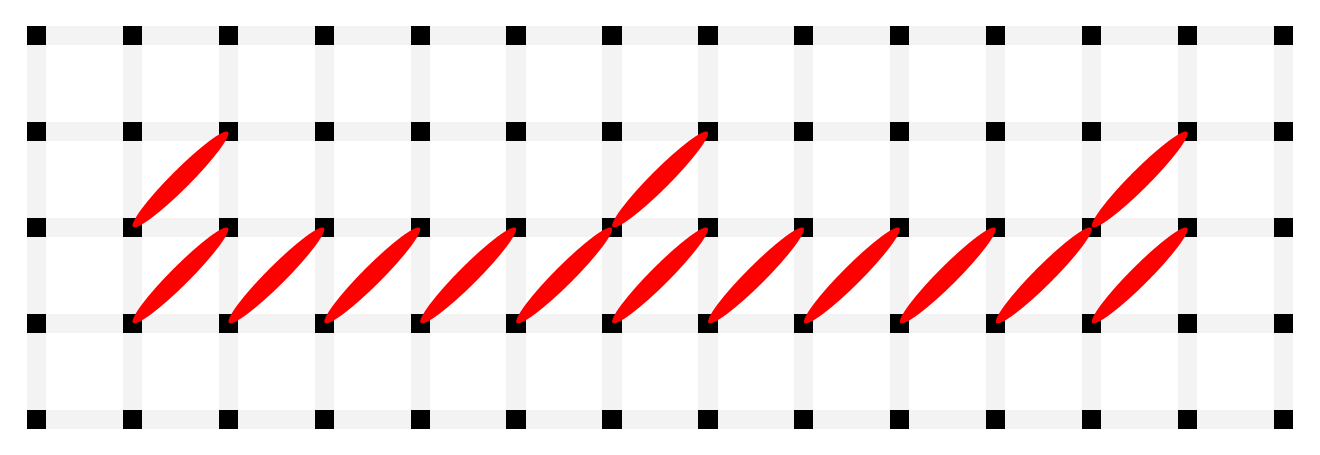
(d) A wide comb with 3 teeth 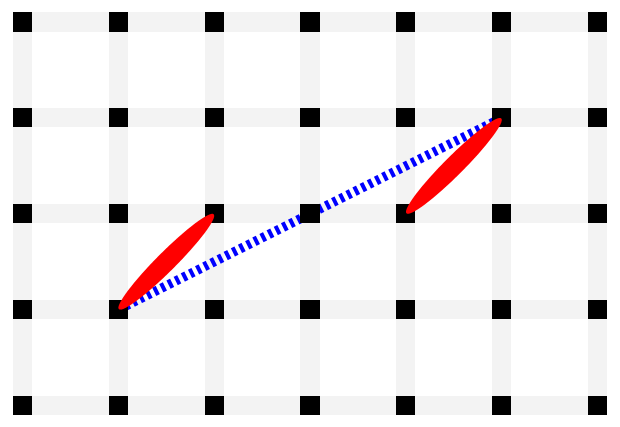
(e) Two example stiches 
(f) Two example stiches Figure 1: Diagrams for Problem 5 - Show that the minimum length of thread (front and back) needed to stitch every square in an m×n rectangular grid is mn(√2 + 1) − 1. An example with m=3 and n=4 is shown in Figure 1a.
- A comb with n teeth is a pattern of width 2n − 1 and height 2 that stitches every square in the bottom row and every other square in the top row; an example of this pattern with n=4 is shown in Figure 1b. What is the minimum length of thread (front and back) needed to stitch this pattern, in terms of n?
- A tall comb with n teeth is a pattern of width 2n − 1 and height 3 that stitches every square in the bottom row and every other square in the top two rows; an example of this pattern with n=4 is shown in Figure 1c. What is the minimum length of thread (front and back) needed to stitch this pattern, in terms of n?
- A wide comb with n teeth is a pattern of width 5n − 4 and height 2 that stitches every square in the bottom row and every fifth square in the top row; an example of this pattern with n=3 is shown in Figure 1d. What is the minimum length of thread (front and back) needed to stitch this pattern, in terms of n?
- Can you prove anything in general about the minimum length of thread needed to stitch a pattern?
-
You may have heard of the Borromean rings (a famous pattern of 3 equal circles) or the Olympic rings (a famous pattern of 5 equal circles). The unchanging rings (which aren't famous because we just made up the name) are a pattern that can be made from different numbers of circles, with some special points on them marked.
A system of unchanging rings must satisfy three unchanging rules:
- If two circles meet at a marked point, they share exactly two marked points.
- If two marked points lie on a common circle, they must share exactly two common circles.
- We can get from any circle to any other by some number of hops along marked points.
One possible system of unchanging rings is shown below:
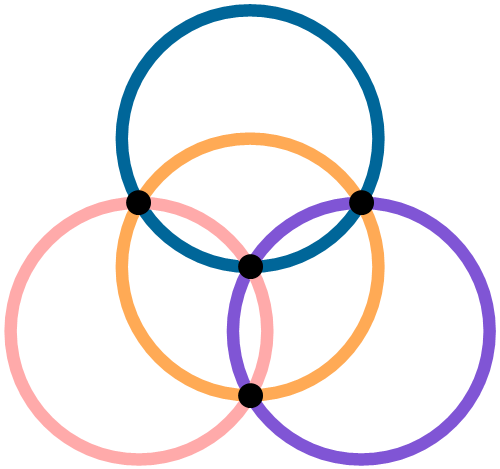
- Draw a system of unchanging rings with more than 4 circles, all equal in size.
- Prove that every system of unchanging rings (whether made up of ordinary circles or math circles) has an unchanging constant n, such that every circle contains exactly n marked points, and every marked point is contained in exactly n circles. (In the example drawn above, n=3.)
- In a system of unchanging rings with unchanging constant n, what is the maximum number of circles?
- For some n, find a nonempty system of unchanging rings with unchanging constant n such that it has fewer circles than the maximum you found in part c.
Problem #3 is due to Leo Kargin (MC 2022–2023). Problem #4 is due to Maya Kalai (MC 2023). Problems #1, #2, #5, and #6 were written by the Mathcamp staff.
FAQ Answers
Many applicants asked us questions to clarify the statements of Quiz problems via our QQ helpline. Here are some of the questions and our answers; you might find them helpful!
Problem 1
In Problem 1b, do the side lengths a, b, c, and d need to be integers?
No, the side lengths can be any positive real numbers.
In Problem 1b, what freedom do we have in cutting the second rectangle?
The second rectangle should be cut along a line segment that starts on the bottom edge and ends at the top edge; you can choose where it starts and ends as necessary to make your solution work.
Problem 3
Are compound questions allowed?
Questions can ask about several clauses (combined with, e.g., 'and', 'or', 'if'), but an answer will still only have a single truth value. For example, if you asked, "Is Mathcamp awesome, and is the sky green?", the true answer would be "no" because only one of the two parts connected by "and" is true.
Does <example question> count as a paradox?
The universe explodes in paradox if, no matter which answer the mathematician gave, an observer would immediately be able to say, "That violated the rules that mathematician was supposed to follow." Some questions just don't have clear answers, or don't have known answers, and these will not cause the universe to explode. For example, nothing happens if you ask "Is the statement, 'This statement is false,' true?" or "Is the Riemann hypothesis true?" or "Will it rain tomorrow?"
Problem 4
Do we have access to a random number generator? If so, what kind?
Yes; you should describe a method of giving out the slices of cake to Mathcampers which involves making some decisions at random at some point. You can use any tools you like to do this; all that needs to be true is that every time you make a random decision between several options, it's clear what the probability of each option is.
Are the numbers x1, x2, ..., xn real or rational?
We intended them to be real numbers. That being said, if you have a solution that only works for rational numbers, we'd also be very interested in seeing it! (It's possible that your solution would be equivalent to a fully general solution, if only you had used a slightly different tool to make random decisions.)
Problem 5
In Problem 5a, are you sure that the minimum length is correct?
We're sure, but it's easy to get a smaller minimum length if you don't follow all the rules of stitching. If you're getting a smaller answer, check that every front stitch is the diagonal of a single 1 by 1 square; check that front and back stitches alternate; check that every back stitch has a positive length.
Problem 6
What are the "hops" allowed in unchanging rule III?
Imagine starting on one circle, moving to a second circle that shares a marked point with the first, then maybe moving to a third circle that shares a marked point with the second, and repeating this any number of times you like. You should be able to get from any circle to any other this way. The purpose of this condition is connectedness: otherwise, you'd be able to solve Problem 6a by drawing two copies of our example diagram side-by-side!
In Problem 6a, the circles are required to be equal in size; is this true for the rest of the problem?
Very much no, because in the rest of the problem, they might no longer be geometrical objects! They might be drawn with circles of the same size, or with circles of different sizes, but they might not be representable by circles at all. All that matters is which marked points are part of which circles, and of course that the unchanging rules are satisfied.
Do all intersection points between circles have to be marked?
No, you can choose which points on the circles to mark to satisfy the "unchanging rules". (The rules don't apply to intersection points that are not marked points.)





